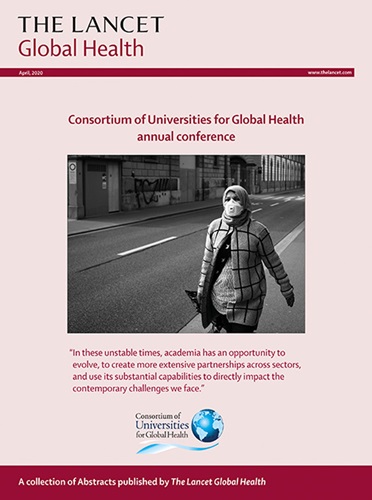七个拉丁美洲国家痴呆症风险因素的人口可归因分数:利用横截面调查数据进行的分析。
IF 19.9
1区 医学
Q1 PUBLIC, ENVIRONMENTAL & OCCUPATIONAL HEALTH
引用次数: 0
摘要
背景 全球约 40% 的痴呆症病例可归因于 12 个潜在的可改变风险因素。然而,这些风险因素在拉丁美洲所占的比例仍然未知。我们使用了在阿根廷、巴西、玻利维亚、智利、洪都拉斯、墨西哥和秘鲁进行的七项具有全国代表性的横断面调查数据,这些调查测量了 12 个可改变的痴呆症风险因素(教育程度较低、听力损失、高血压、肥胖、吸烟、抑郁、社会隔离、缺乏运动、糖尿病、酒精摄入过量、空气污染和脑外伤)。数据收集时间为 2015 年至 2021 年。样本量从 5995 到 107 907 名参与者(年龄≥18 岁)不等。我们计算了每个国家的风险因素流行率和共性,并使用先前荟萃分析中的相对风险得出加权 PAF。使用随机效应荟萃分析得出了拉丁美洲的汇总 PAFs。结果拉丁美洲各国归因于 12 个可改变风险因素的痴呆症病例的总体比例各不相同:智利的加权 PAF 为 61-8%(95% CI 为 37-9-79-5),阿根廷为 59-6%(35-8-77-3),墨西哥为 55-8%(35-7-71-5),玻利维亚为 55-5%(35-9-70-4),洪都拉斯为 53-6%(33-0-69-3),巴西为 48-2%(28-1-63-9),秘鲁为 44-9%(25-8-61-2)。拉丁美洲痴呆症的总体 PAF 为 54-0%(48-8-59-6)。拉丁美洲国家总体加权 PAF 最高的疾病是肥胖症(7%)、缺乏运动(6%)和抑郁症(5%)。肥胖、缺乏运动和抑郁是七个拉美国家痴呆症的主要风险因素。这些发现对拉丁美洲的公共卫生和有针对性的痴呆症预防策略具有重要意义。尽管这些结果提供了有关拉美国家的新信息,但在解释这些发现时,应考虑人口统计学和不同调查的代表性差异。本文章由计算机程序翻译,如有差异,请以英文原文为准。
Population attributable fractions for risk factors for dementia in seven Latin American countries: an analysis using cross-sectional survey data.
BACKGROUND
Approximately 40% of dementia cases worldwide are attributable to 12 potentially modifiable risk factors. However, the proportion attributable to these risks in Latin America remains unknown. We aimed to determine the population attributable fraction (PAF) of 12 modifiable risk factors for dementia in seven countries in Latin America.
METHODS
We used data from seven cross-sectional, nationally representative surveys with measurements of 12 modifiable risk factors for dementia (less education, hearing loss, hypertension, obesity, smoking, depression, social isolation, physical inactivity, diabetes, excessive alcohol intake, air pollution, and traumatic brain injury) done in Argentina, Brazil, Bolivia, Chile, Honduras, Mexico, and Peru. Data were collected between 2015 and 2021. Sample sizes ranged from 5995 to 107 907 participants (aged ≥18 years). We calculated risk factor prevalence and communalities in each country and used relative risks from previous meta-analyses to derive weighted PAFs. Pooled PAFs for Latin America were obtained using random effect meta-analyses.
FINDINGS
The overall proportion of dementia cases attributed to 12 modifiable risk factors varied across Latin American countries: weighted PAF 61·8% (95% CI 37·9-79·5) in Chile, 59·6% (35·8-77·3) in Argentina, 55·8% (35·7-71·5) in Mexico, 55·5% (35·9-70·4) in Bolivia, 53·6% (33·0-69·3) in Honduras, 48·2% (28·1-63·9) in Brazil, and 44·9% (25·8-61·2) in Peru. The overall PAF for dementia was 54·0% (48·8-59·6) for Latin America. The highest weighted PAFs in Latin American countries overall were for obesity (7%), physical inactivity (6%), and depression (5%).
INTERPRETATION
The estimated PAFs for Latin American countries were higher than previous global estimates. Obesity, physical inactivity, and depression were the main risk factors for dementia across seven Latin American countries. These findings have implications for public health and individually targeted dementia prevention strategies in Latin America. Although these results provide new information about Latin American countries, demographics and representativeness variations across surveys should be considered when interpreting these findings.
FUNDING
None.
求助全文
通过发布文献求助,成功后即可免费获取论文全文。
去求助
来源期刊

Lancet Global Health
PUBLIC, ENVIRONMENTAL & OCCUPATIONAL HEALTH-
CiteScore
44.10
自引率
1.20%
发文量
763
审稿时长
10 weeks
期刊介绍:
The Lancet Global Health is an online publication that releases monthly open access (subscription-free) issues.Each issue includes original research, commentary, and correspondence.In addition to this, the publication also provides regular blog posts.
The main focus of The Lancet Global Health is on disadvantaged populations, which can include both entire economic regions and marginalized groups within prosperous nations.The publication prefers to cover topics related to reproductive, maternal, neonatal, child, and adolescent health; infectious diseases (including neglected tropical diseases); non-communicable diseases; mental health; the global health workforce; health systems; surgery; and health policy.
 求助内容:
求助内容: 应助结果提醒方式:
应助结果提醒方式:


